Symbols Used In Spinifex Women’s Collaborative Artwork
In November 2017, Spinifex Artists attended the opening of their exhibition at Japingka Aboriginal Art. The artists explained how they used symbols in their work.
This large two metre Women's Collaborative painting from the Spinifex Arts Project was painted in 2017. The work is titled Kuru Ala, The Home of the Seven Sisters. The senior Spinifex women have painted a sacred women’s story or Tjukurpa. In this work, the Seven Sisters are moving across the Great Victoria Desert in pursuit of a large carpet snake.
The Songline
The story, also known as Kungkarangkalpa Tjukurpa, is a major Western Desert songline. A songline is the path taken by Creation People as they moved across the country. As they travel, they created the world, waterholes, trees, claypans, rocky outcrops, rock holes, sand hills, the Spinifex plains and the animals. These stories have been passed on from generation to generation in songs. The songs refer to real places that are found along the journey track that people have walked since the Ancestors.
Spinifex people traveled these parts of the country in groups. During times of drought, they knew which rock holes were permanent sources of water. They would gather there in larger numbers to see out the dry time.

Crossover With Men’s Story
Senior elder Lennard Walker was born in the place where this Seven Sisters story occurs. He is the custodian of the Kuru Ala story (meaning Eyes Open) and Wati Kutjara Tjukurpa story. The women have to ask his permission to go on this land. He always agrees. Lennard said that the older Spinifex people who grew up on this land knew every rock hole and the song that went with it. The songs told the Creation story of each place. The stories weren’t just about place; they were often moral guides.
The Significance of Rock Holes
Rock holes are distributed widely in Spinifex country and have always been highly significant places for local people. There are important cultural stories associated with them. The rock holes are not just sources of water. They are also places for important life events like birth or death. Animals are also attracted to the water sources so they important sites for food as well.
Spirit Guardians
Every Spinifex artist includes the water sources in their map of country. The people were traditionally seasonal-nomadic hunters, so these places were significant for survival. The rock holes were also important places to go to speak with the spirit guardians if you weren’t successful in getting food. A male hunter might go to a rock hole that he knows is guarded by a powerful Serpent Spirit to ask for its help.

Danger for Strangers
Spinifex people believe that strangers should not go to these sacred places on their own as the spirits can be dangerous forces. You have to be the right person through birth, through family connection to go there. During a visit, a local person might call out to whatever Spirit Being is in that place and say, “You know me, I’m family. I am bringing someone with me. It is alright that we come.”
Some of the iconography in the Women’s Collaborative can be identified as a rock hole, a footprint, a wind shelter, a path that is travelled on or a snake. These identifiable elements are useful guides for us to understand elements of the work. Westerners are often attracted to the specifics in the art because these symbols help us to understand the meaning of the artwork.
The artists are involved in a creative process where they are reflecting on their country as they paint. It is helpful to think of a painting like this as a fluid map. If you listen to the artists describing the elements, they might change things slightly from one telling to the next. In this regard, there is no correct interpretation of a symbol that will always be that way. This is part of the culture that is different from the Western way of thinking, where a meaning may be assigned and it is assumed that it won’t change in context.
Right Hand Side of Painting (Painted by Tjaruwa Woods)
Tjaruwa is painting her country, which is the central to northern part of the Spinifex lands of Western Australia. This is an area with abundant rock holes, which she represents in her work. Tjaruwa is painting the same region as Kanta Kathleen Donnegan.
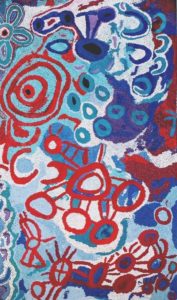
Top Centre to The Right (Painted by Tjaruwa Woods)
The large red circles (top centre right) in the painting represent the home of the Seven Sisters, Kura Ala. The land in this country is red granite. There are two caves, and that is why the name for the place translates as “eyes open”. This is a secret place for women’s business.
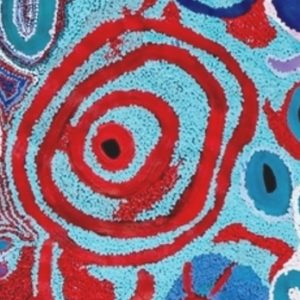
Top Right Corner (Painted by Tjaruwa Woods)
The blue semi circles are the Seven Sisters sitting together.
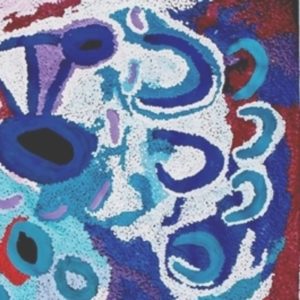
Centre Right (Painted by Tjaruwa Woods)
The blue circles are the different water holes in the region. Some are waterholes that have water only after rain while others are permanent water sources.
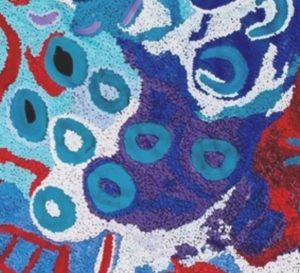
Bottom Right (Painted by Tjaruwa Woods)
The red circles are different to other sites in the area. As the women were being chased by the spirit person Nyiru, they moved through vast areas of the country. The lines are the paths that they walked between rock holes or food sites.

Centre (Painted by Tjaruwa Woods)
The larger blue horseshoe shape in the centre is a windbreak called a Yuul. In the story, the Seven Sisters were building a wiltja, meaning a smaller shelter, when they looked across and saw a carpet snake. This was actually the lustful older man, Nyiru who was trying to catch a wife. He had been pursuing the women. Nyiru had changed form into a snake to trick the women.
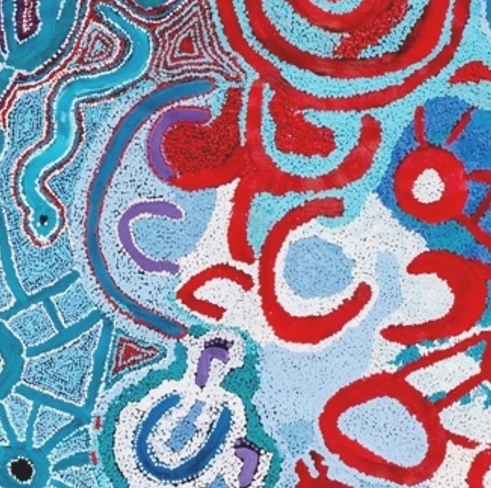
The Events in The Story
The carpet snake is good edible food for the women, so they are excited to see it. The carpet snake goes underground, so they start to dig to follow it. Even as they dig, Nyiru is watching the scene. He can be the snake as well as the observer. He has the power to transform into different forms or to occupy multiple forms at the same time. He can also be in different places. This is something Creation Beings were able to do. As the Seven Sisters dig for the snake, they are creating the country that now exists on that site. They are in the country, and at the same time, they are creating it.
The Sisters capture the snake and kill it with their digging sticks. They cook it. As soon as they start to eat, they know something is wrong. The snake has made them sick. They realise it is the man Nyiru who has transformed himself into the kuniya (snake) and tricked them.
Bottom Centre (Painted by Jennifer Mitchell)
The blue and purple narrow panel from the bottom centre to the middle of the painting shows horseshoe shapes and footprints. These are the Seven Sisters walking toward their home Kuru Ala.
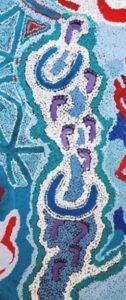
Centre (Painted by Kanta Kathleen Donnegan)
The Creation Being Nyiru is only represented in this painting by the blue carpet snake in the centre of the painting. He is always hiding which might be why his other forms are not included.
The small waterhole to the right of the snake is called Mamutju.
The larger waterhole directly above is called Ilkurlka. You can see the Sisters sitting around it.
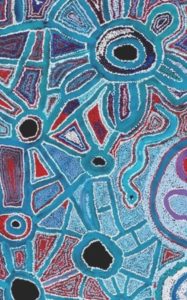
Bottom Left Corner (Painted by Myrtle Pennington)
This is a representation of the country to the east of Spinifex lands, on the border between Western Australia and South Australia. The shapes represent the Seven Sisters inside a small shelter called a wiltja.
Footnote: Artist Angkaliya Mitchell painted a tiny bit of the bottom left section during a one day visit. Her name is not included the major artist credits.

Centre Left (Painted by Kanta Donnegan)
This is a painting of Kanta’s country showing waterholes and the walking tracks between them.
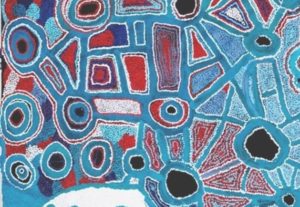
Top Left (Painted by Ngalpingka Simms)
Ngalpingka is from the Patjarr community to the north west of Warburton. It is a very long way from Spinifex country. This country connects to the Seven Sisters story. Ngalpingka is the wife of the Kura Ala site custodian Lennard Walker.
Towards the left side of the painting is represented country which is considered as very sacred. It is land which crosses over between a women’s and men’s story. The painting of this area shows major waterholes and the walking tracks between them. The waterhole in the centre of the top corner shape is Waiyu which was Ngalpingka’s birthplace. The waterhole in the very middle of the flower shape in the top centre is Ilkurlka. The petal shapes are the Sisters sitting around the waterholes. Between the two major waterholes in this section and slightly lower is a small black waterhole surrounded by a purple colour and this is called Tjuntjun.
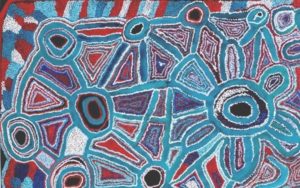
More Information:
- See More Paintings By Spinifex Artists
- Read Working With The Spinifex Art Project
- View Other Spinifex Paintings
